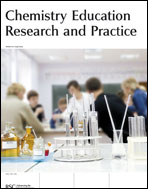The development of an open-ended drawing tool: an alternative diagnostic tool for assessing students' understanding of the particulate nature of matter
Abstract
Many studies in the chemical education literature report students' alternative conceptions in chemistry and the difficulty they present for future learning. In this paper, we review existing diagnostic tools used to uncover students' alternative conceptions in chemistry and suggest that there are two fundamental issues with such instruments, namely, the breadth of topics and concepts assessed and the reliance on forced choice responses. We argue that while existing instruments provide a way to assess students' overall understanding of chemical concepts, they cannot assess depth of understanding of any single concept, such as the particulate nature of matter – one of the central, organizing ideas in chemistry. Instead, we propose using qualitative approaches that utilize drawing tasks as an alternative diagnostic tool to uncover students' underlying struggles with fundamental chemistry concepts. Using this approach, we investigated college students' ability to balance chemical equations and draw appropriate particulate representations of those reactions. Emerging categories from students' particulate drawings were coded into several subcategories and revealed a number of underlying issues, such as lack of understanding of appropriate relationships between reacting species in solution, oxidation numbers, states and valences of species, the characteristics and nature of ions in solids and differences between ionic and covalent bonds. We describe these findings and consider the implications of qualitative-based diagnostics for instruction and science learning as a formative assessment tool.
- This article is part of the themed collection: Diagnostic Assessment in Chemistry

 Please wait while we load your content...
Please wait while we load your content...